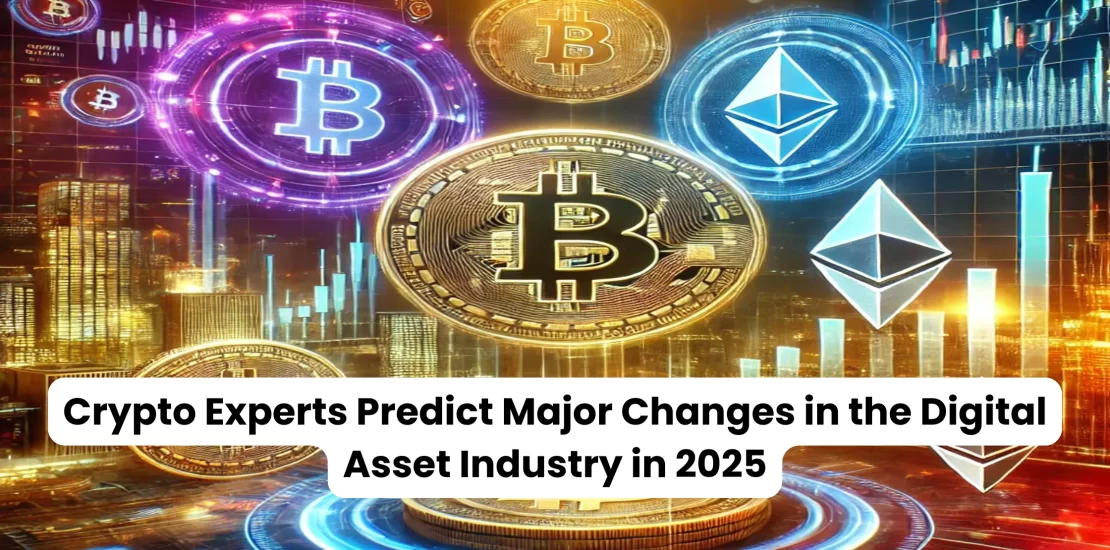- December 31, 2024
- Posted by: Jackson Bennett
- Category: News

Experts in the field believe the crypto landscape is set to undergo a major transformation in 2025. In the coming years, the industry is poised to undergo powerful shocks that will alter how digital assets are utilized. Let’s explore the major trends that crypto gurus anticipate will dictate the state of the industry by 2025.
1. Stablecoin-Powered Payments are the Rise
Borderless.xyz CEO Kevin Lehtiniitty thinks the payments industry is going to take a major shift in 2025. We expect that stablecoins, digital currencies that are linked to a stable asset such as the U.S. dollar, will be the main way that value crosses borders. The original use case of cryptocurrency—replacing traditional banking systems with a faster, cheaper method—is finally starting to take root, says Lehtiniitty.
Lehtiniitty told TheStreet Crypto: ‘Starting 2025, the payments industry will go from a slow and expensive network of correspondent banks to fast, cheap, internet native money by the use of stablecoins’. This is expected to see the rise of new financial technologies, including the rise of global fintech firms and neobanks built on blockchain-based systems.
The game changer that allows businesses and consumers to avoid traditional financial institutions, and be able to do cross-border transactions without having to jump through as many hoops as they traditionally would is stablecoins. This will also spur the growth of blockchain-based payment systems capable of handling global transactions at a bare minimum cost and time.
2. A Surge in Onchain Startups and Innovation
But as the regulatory environment becomes friendlier to crypto in the United States, venture capital will be hard to resist and poured into on-chain startups. Such are companies that do business using blockchain technology, which has made business more transparent, faster and more secure. By 2025, we will see a boom of on-chain startups that incorporate accounts receivable and payroll management, creator payments, remittances and more.
The coming years, according to Lehtiniitty, will see blockchain-based assets move out of general speculation into real-world use cases. ‘It’s speculative here as a use case, but we’re in the post-speculative era, real innovation time,’ he said. The continued adoption of blockchain technology by businesses and individuals alike will strengthen this trend and push such growth to levels similar to that of the rapid growth seen in 2021 during the bull run.
The end of an oppressive regulatory regime in the U.S. will likely help a new wave of startups rise with the help of VC capital. Now these companies are signing up millions of clients to blockchain-based solutions in industries including finance, media and entertainment.
3. Regulatory Clarity
Regulatory clarity is, without a doubt, one of the most awaited changes in the crypto industry. The experts expect that the new U.S. presidential administration (former President Donald Trump) will show more deregulated environment that supporting innovation in the crypto space. Many expect clarity about digital assets, which have been the subject of legal uncertainties in recent times.
“Regulatory frameworks are being put in place already, the European Union’s Markets in Crypto Assets regulation (MiCA) will be a leading force in institutioal blockchain technology adoption,” George Georgiades, General Counsel at Borderless.xyz. That sounds good, but MiCA is not perfect, and it is expected to deliver a more stable and predictable regulatory environment for blockchain based assets.
Georgiades added that ‘greater engagement between regulators and market participants will bring clarity on a number of complex legal issues’. The evolving anti-money laundering regulations and the U.S. Securities and Exchange Commission’s (SEC) treatment of certain digital assets as securities are included. Encouraging the growth of blockchain technology could come from a reduction in enforcement actions and more cooperation between members of Congress and the crypto industry.
4. The Convergence of AI and Decentralized Physical Infrastructure Networks (DePIN)
In this year of 2025, the realm of artificial intelligence (AI) to decentralized physical infrastructure networks (DePIN) will continue to grow until it becomes one of the most exciting innovations. A dePIN is a decentralized system that uses distributed physical infrastructure, for example, storage, computing power and bandwidth.
In 2025, Clara Tsao, a founding officer at the Filecoin Foundation, expects the overlap between AI and DePIN to rapidly expand. DePIN could help break the scaling bottleneck, democratize the use of computational resources and seamlessly embed with the vast amounts of secondary data that is readily available. This could be a game changer for anyone with AI-driven processes from finance to healthcare.
Tsao said the technology has been adopted by AI builders more than twice as much as they were a year ago, up from 5% to 12%. As more AI companies look to build trust in their data and put computational resources necessary for AI in a decentralized way, we expect this trend to continue as more AI companies discover ways DePIN can help them meet their infrastructure needs.
5. A More Collaborative Approach Between Regulators and Market Participants
In the coming years, we’re on the cusp of closer coordination between regulators and the crypto market participants. This constant growth in crypto will mean regulators are more likely to get in touch with prominent industry members to clarify the rules and guidelines. Such cooperation could make for a less shaky environment for innovation, which in turn could mean supportive business operations and less threat of a dash of regulatory changes out of the blue.
Georgiades added: “We expect to see regulators and market participants engaging more, to provide clarity on a number of intricate legal questions.” The interaction between the two is going to be very important for the healthy sustainable growth of the crypto industry in the foreseeable future because of the regulatory, technological and the market dynamics involved.
Add a comment
You must be logged in to post a comment.



